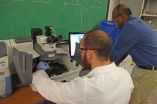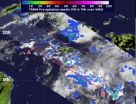(Press-News.org) (Edmonton) Children who bask in the nighttime glow of a TV or computer don't get enough rest and suffer from poor lifestyle habits, new research from the University of Alberta has shown.
A provincewide survey of Grade 5 students in Alberta showed that as little as one hour of additional sleep decreased the odds of being overweight or obese by 28 per cent and 30 per cent, respectively. Children with one or more electronic devices in the bedroom—TVs, computers, video games and cellphones—were also far more likely to be overweight or obese.
"If you want your kids to sleep better and live a healthier lifestyle, get the technology out of the bedroom," said co-author Paul Veugelers, a professor in the School of Public Health, Canada Research Chair in Population Health and Alberta Innovates – Health Solutions Health Scholar.
Veugelers, director of the Population Health Intervention Research Unit that works with the Alberta Project Promoting active Living and healthy Eating (APPLE Schools), said the research is the first to connect the dots on the relationship between sleep, diet and physical activity among kids.
Nearly 3,400 Grade 5 students were asked about their nighttime sleep habits and access to electronics through the REAL Kids Alberta survey. Half of the students had a TV, DVD player or video game console in their bedroom, 21 per cent had a computer and 17 per cent had a cellphone. Five per cent of students had all three types of devices.
Some 57 per cent of students reported using electronics after they were supposed to be asleep, with watching TV and movies being the most popular activity. Twenty-seven per cent of students engaged in three or more activities after bedtime.
Researchers found that students with access to one electronic device were 1.47 times as likely to be overweight as kids with no devices in the bedroom. That increased to 2.57 times for kids with three devices, with similar results reported among obese children.
More sleep also led to significantly more physical activity and better diet choices, researchers found.
Co-author Christina Fung noted that children today are not sleeping as much as previous generations, with two-thirds not getting the recommended hours of sleep per night. In addition to healthy lifestyle habits, a good night's sleep has been linked to better academic outcomes, fewer mood disorders and other positive health outcomes, she said.
"It's important to teach these children at an earlier age and teach them healthy habits when they are younger."
###
The research was published in September by the journal Pediatric Obesity, in an early online release. The REAL Kids Alberta evaluation was funded through a contract with Alberta Health.
TV, devices in kids' bedrooms linked to poor sleep, obesity
2012-10-23
ELSE PRESS RELEASES FROM THIS DATE:
Exercise and complete decongestive therapy best ways to manage lymphedema, MU expert says
2012-10-23
COLUMBIA, Mo. –Nearly 40 percent of breast cancer survivors suffer from lymphedema, a chronic condition that causes body limbs to swell from fluid buildup, as a result of lymph node removal and radiation therapy. A cure for lymphedema does not exist, so individuals with the condition must find ways to manage the symptoms throughout their lifetimes. Now, a team of researchers and clinicians working with a University of Missouri lymphedema expert has found that full-body exercise and complete decongestive therapy (CDT) are the best ways for patients to minimize their symptoms ...
Climate variability and conflict risk in East Africa measured by Boulder team
2012-10-23
While a new study led by the University of Colorado Boulder shows the risk of human conflict in East Africa increases somewhat with hotter temperatures and drops a bit with higher precipitation, it concludes that socioeconomic, political and geographic factors play a much more substantial role than climate change.
According to CU-Boulder geography Professor John O'Loughlin, the new CU-Boulder study undertaken with the National Center for Atmospheric Research in Boulder is an attempt to clarify the often-contradictory debate on whether climate change is affecting armed ...
Evolution of new genes captured
2012-10-23
Like job-seekers searching for a new position, living things sometimes have to pick up a new skill if they are going to succeed. Researchers from the University of California, Davis, and Uppsala University, Sweden, have shown for the first time how living organisms do this.
The observation, published Oct. 19 in the journal Science, closes an important gap in the theory of natural selection.
Scientists have long wondered how living things evolve new functions from a limited set of genes. One popular explanation is that genes duplicate by accident; the duplicate undergoes ...
Rapid changes in the Earth's core: The magnetic field and gravity from a satellite perspective
2012-10-23
Annual to decadal changes in the earth's magnetic field in a region that stretches from the Atlantic to the Indian Ocean have a close relationship with variations of gravity in this area. From this it can be concluded that outer core processes are reflected in gravity data. This is the result presented by a German-French group of geophysicists in the latest issue of PNAS (Proceedings of the National Academy of Sciences of the United States).
The main field of the Earth's magnetic field is generated by flows of liquid iron in the outer core. The Earth's magnetic field protects ...
New Stanford analysis provides fuller picture of human expansion from Africa
2012-10-23
A new, comprehensive review of humans' anthropological and genetic records gives the most up-to-date story of the "Out of Africa" expansion that occurred about 45,000 to 60,000 years ago.
This expansion, detailed by three Stanford geneticists, had a dramatic effect on human genetic diversity, which persists in present-day populations. As a small group of modern humans migrated out of Africa into Eurasia and the Americas, their genetic diversity was substantially reduced.
In studying these migrations, genomic projects haven't fully taken into account the rich archaeological ...
Milky Way's black hole getting ready for snack
2012-10-23
Get ready for a fascinating eating experience in the center of our galaxy.
The event involves a black hole that may devour much of an approaching cloud of dust and gas known as G2.
A supercomputer simulation prepared by two Lab physicists and a former postdoc suggests that some of G2 will survive, although its surviving mass will be torn apart, leaving it with a different shape and questionable fate.
The findings are the work of computational physicist Peter Anninos and astrophysicist Stephen Murray, both of AX division within the Weapons and Complex Integration Directorate ...
New self-healing coating for aluminum developed to replace cancer-causing product
2012-10-23
RENO, Nev. – A research team at the University of Nevada, Reno has developed a new environmentally-friendly coating for aluminum to replace the carcinogenic chromate coatings used in aerospace applications. The chromate conversion coatings have been used for more than 50 years to protect aluminum from corrosion.
The team presented their research last week at the international Pacific Rim Meeting on Electrochemical and Solid-State Science in Hawaii.
"It was well received at the conference," Dev Chidambaram, lead scientist and assistant professor of materials science ...
NASA sees 18th Atlantic depression form
2012-10-23
Tropical Depression 18 (TD18) formed over the southwestern Caribbean Sea at 11 a.m. EDT on Oct. 22, and NASA's TRMM satellite saw a "hot towering" thunderstorm near its center of circulation hinting that it could become a tropical storm soon. A tropical storm watch has been issued for Jamaica.
When NASA's Tropical Rainfall Measuring Mission (TRMM) satellite flew over the developing TD18 early on Oct. 22 at 0040 UTC (Oct. 21 at 8:40 p.m. EDT), the satellite measured rainfall rates within the low pressure area and measured cloud heights of the thunderstorms that make up ...
Additive restores antibiotic effectiveness against MRSA
2012-10-23
Researchers from North Carolina State University have increased the potency of a compound that reactivates antibiotics against methicillin-resistant Staphylococcus aureus (MRSA), an antibiotic-resistant form of Staphylococcus that is notoriously difficult to treat. Their improved compound removes the bacteria's antibiotic resistance and allows the antibiotic to once again become effective at normal dosage levels.
NC State chemist Christian Melander had previously proven the effectiveness of a 2-aminoimidazole compound in reactivating antibiotics against resistant bacterial ...
Crusty foods may worsen heart problems associated with diabetes
2012-10-23
URBANA – A University of Illinois study suggests avoiding cooking methods that produce the kind of crusty bits you'd find on a grilled hamburger, especially if you have diabetes and know you're at increased risk for cardiovascular disease because of your diagnosis.
"We see evidence that cooking methods that create a crust—think the edge of a brownie or the crispy borders of meats prepared at very high temperatures—produce advanced glycation end products (AGEs). And AGEs are associated with plaque formation, the kind we see in cardiovascular disease," said Karen Chapman-Novakofski, ...

